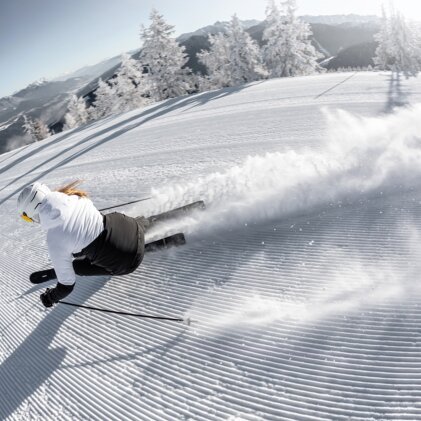
Your guide for every riding style
Flip, switch, mute... No, we're not talking about a DJ's set on a radio show. These are all terms that are used in freestyle skiing. But if you're a die-hard fan, you probably already know that. And of course - the right freestyle ski size is also crucial for perfect tricks and maximum fun in parks, halfpipes or the backcountry.
Fighting your way through the seemingly endless jungle of ski setups can be a little difficult - maybe even trickier than mastering the right slang. But don't worry: INTERSPORT Rent has teamed up with the experts at Völkl, and we're happy to tell you how to find the perfect gear and ski length for freestyle skiing. With the right skis, bindings and accessories, you can optimize your skills and get the most out of your riding.
But first things first: the right freestyle ski size depends primarily on what you intend to do with it.
Freestyle ski size: what to consider when choosing
Freestyle skis are actually a generic term for different types of skis that differ in features and characteristics: Park skis for technical tricks, playful all-mountain models for versatility, and freeride skis for off-piste. While your height is a good guide, you should also adjust based on where you hit the different terrain.
To get the most out of your setup, it is important to keep the following factors in mind:
- Favourite "playground" (park, halfpipe, off-piste, all-mountain)
- Height and weight
- Personal riding style
- Riding ability and experience
As a general rule of thumb, taller and heavier skiers need longer skis - but as mentioned above, there are more factors at play than just your height and weight!
First things first: body height & the right freestyle ski size
Before we get into the details, let's review the basic differences between shorter and longer models. The length of the ski has a major impact on your skiing behavior, directly affecting your control, speed and maneuverability.
A first important starting point when choosing the size of your skis is your height. Depending on your riding style and area of use, you may be able to deviate from this.
If you want to know more about the right skis for your favourite terrain: read on - we'll tell you more later! Or just visit our RENTertainers in the shop - they can give you professional advice and have the right skis, boots, bindings and accessories on hand.
Advantages and disadvantages of a shorter freestyle ski size
Freestyle skis that are shorter than your height have specific advantages and disadvantages that can significantly affect your riding.
Advantages:
- Great for tricks on kickers, switch ups on rails and more complex tricks
- Better for quick direction changes.
- More responsive and easier to control.
Disadvantages:
- Won't be so fast.
- Offer less flotation in deep snow.
- Less stability at higher speeds.
Pros and cons of a longer freestyle ski size
Longer skis that are the same size or larger than you have their own characteristics that are especially important in certain disciplines.
Advantages:
- Great for big jumps, halfpipes and off-piste terrain.
- Provide more flotation in deep snow.
- Reach higher speeds and provide more speed for "Big Air" Jumps.
- Offer more stability when landing.
Disadvantages:
- Turn more slowly.
- More difficult to control when performing technical tricks.
Freestyle ski size chart: How to find the right ski length for your height
The following table provides a rough guide to what freestyle ski size may be appropriate for your height and preferred use. Please note, however, that these approximate values may vary depending on your individual skiing style, weight, and preferences.
| Body size | Jibbing | Jumps | All-Mountain | Backcountry |
|---|---|---|---|---|
| 160 cm | 145-150 cm | 155-160 cm | 150-155 cm | 160-170 cm |
| 170 cm | 155-160 cm | 165-170 cm | 160-165 cm | 170-180 cm |
| 180 cm | 165-170 cm | 175-180 cm | 170-175 cm | 180-190 cm |
| 190 cm | 175-180 cm | 185-190 cm | 180-185 cm | 190-200 cm |
Freestyle ski size based on preferred terrain
Park, halfpipe or natural obstacles in the backcountry: what is your favourite playground? Depending on your preferred terrain, you should adjust the length of your skis accordingly.
The right length of freestyle skis for park & halfpipe
For this groomed, hard terrain, you need skis that are specifically tailored to your riding style. The requirements vary greatly depending on your preferred focus.
Option 1 - Optimal freestyle ski size for jibs & CO
If you plan on doing a lot of jibbing and riding rails and boxes, look for playful, maneuverable skis. They should be easy to turn and offer maximum control.
- Slightly shorter ski (compared to all-mountain skis)
- Ski length to approx. between chin and nose
A shorter ski size gives you more control over the skis, increases manoeuvrability and reduces swing weight in turns and flips. Other features that the skis should have:
- Soft flex for better maneuverability
- Tip and tail rocker
- Medium width for a good balance between stability and maneuverability
- Our favourites: Völkl's Revolt 86 or Revolt 90
Expert tip: The more technical and demanding your rail tricks become, the shorter your skis should be for maximum control.
Option 2 - The right ski length for jumps
If you want to make big jumps, you need to go fast. That means you need skis that give you stability at high speeds and on landings. You can usually achieve this with slightly longer skis. However, you don't want your skis to be too long, or you'll have too much swing weight when you're doing tricks in the air.
- Typical All-mountain ski length or
- Skis that are about as long as you are tall
The bigger the jumps, the more important stability becomes. For very large kickers, you can also choose skis that are slightly taller than your body size. Other features that the ski should definitely have:
- Stiffer flex for more stability
- Camber profile for more pop and precise landings
- Narrow to medium width for direct edge gripping
- Our favourite: Völkl's Revolt 90 or Revolt 84
Option 3 - A bit of both
If both types of skiing are part of your repertoire, consider your personal preference and our tips above.
- Shorter skis are easier to turn and maneuver.
- Longer skis provide more stability and are easier to accelerate.
Ideal characteristics for this ski:
- Moderate flex (medium to stiff)
- Hybrid rocker
- Average to medium width
- Our favourite: Völkl's Revolt 95
Ski length for all-mountain freestyle: Mix of groomed slopes and park
If you want to be out and about in the park as well as on normal slopes and occasionally off-piste, you need a versatile ski that performs everywhere. All-mountain skis are the perfect compromise if you want to have fun in both areas.
- Choose a ski size that is about 5 cm shorter than your height.
- This means that the ski should end between your nose and forehead.
As a result, you only lose a little in manoeuvrability and top speed - but the ski is suitable for almost any terrain. Other features that the ski should have:
- Hybrid Camber
- Tip and tail rocker
- Balanced flex for versatility
- Our favourite: Völkl's 104
Correct freeride ski size for natural terrain (off-piste)
Freeriding off-piste in powder snow, between trees and over natural kickers is certainly the most specialised and rarest area of use.
If you want to take advantage of the mountain's natural conditions, you need freeride skis with sufficient float and stability that are still playful enough for tricks.
- Choose a wide and playful freeride ski so that you can also perform tricks in deep snow.
- You get more lift with a longer ski model than with traditional freeride skis.
- The ski should be your height or about 5 to 15 cm longer (for experienced skiers).
- Our favourite: Völkl's Revolt 95
Our tip: Decide on the area where you spend the most time or choose an all-mountain model as a compromise. For days when you want to ride in the park or enjoy the snow in the backcountry, take advantage of the rental options at the INTERSPORT Rent shop. Our RENTertainers are available at over 800 locations worldwide to give you the perfect setup!
Frequently asked questions about the best freestyle ski size
Can you use freestyle skis on the slopes?
Freestyle skis are more versatile than many people think. All-mountain freestyle models, in particular, are ideal for regular skiing on the slopes. Note, however, special park skis with rounded edges and a softer flex offer less control on hard, steep descents than dedicated skis for the slopes. However, they are great for occasional skiing on slopes between park sessions.
Can you carve on freestyle skis?
Carving is possible with freestyle skis, but not as effectively as with dedicated carving skis. Freestyle models typically have:
- A less pronounced waistline
- Often rounded edges (for park-specific models)
- Softer flex for less carving precision
All-mountain skis with intact edges are still best suited for carving. However, if you mainly want to carve, special carving skis are the better choice.
Are shorter skis better?
Slightly shorter skis are actually advantageous for beginner freestyle skiers, as they
- Are easier to control.
- Need less power easier to turn.
- Are more likely to forgive mistakes.
- Require less effort to perform tricks.
Beginners should start with skis that are about 10-15 cm shorter than their height and work their way up to longer models as their ability increases and more stability is required. Take advantage of the services of the INTERSPORT Rent shop and get perfectly equipped with skis and bindings, boots and many accessories.
How do twin tip freestyle skis differ from standard models?
Twin Tip skis are characterized by the following features:
- Curved front and rear ends (hence the name "twin-tip")
- Enable driving and landing in reverse (switch)
- Often symmetrical design for the same riding behaviour in both directions
- Often centre point for mounting the bindings (mounting point)
These characteristics make them ideal for freestyle maneuvers where you often ride or land backwards.
INTERSPORT Rent Tip
There is no such thing as a freestyle ski that is equally good for all types of terrain. To get the most out of your day in the park or the halfpipe, visit the INTERSPORT Rent Shop! Our local RENTtainers will be happy to help you choose the perfect gear - including the right freestyle ski size for your needs.
Try different models and lengths before you make your decision. You're sure to find the skis, boots, bindings and accessories that suit your style of skiing. And maybe they will even tell you where to find the best natural and artificial obstacles in the area... Have fun jibbing and jumping!





